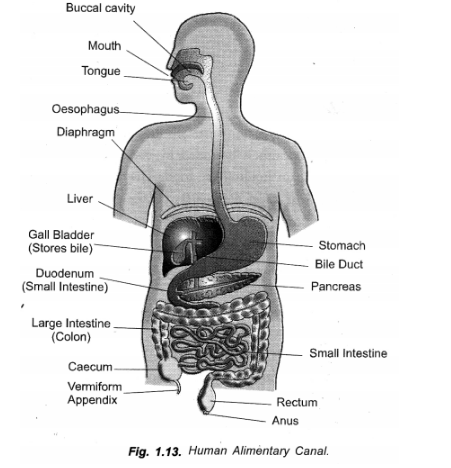Question:
Describe the alimentary canal of man.
Solution:
Alimentary canal (L. alere-to nourish) is a tubular passage extending from mouth to anus through which food passes during its digestion and
absorption. It is about 9 metres in length. Alimentary canal consists of mouth, buccal cavity, oesophagus, stomach, small intestine, large intestine
and anus.

- Mouth: It is a transverse slit like aperture that occurs in between the nose and the chin. Mouth is bounded by two soft, movable sensitive lips, upper and lower. Lips help in holding the food. They also aid in phonation (speech).
- Buccal or Oral Cavity (L. bucca-cheek): It is anterior part of alimentary canal that extends from mouth to pharynx and lies between two jaws, upper (fixed) and lower (movable). It has palate on upper side, throat and tongue on the lower side and cheeks on the lateral sides. Both the jaws contain teeth in semicircular rows or arches.
- It is a muscular, sensory, movable and protrusible flat structure which is attached posteriorly over the lower jaw. Tongue bears taste buds for tasting the quality of food—sweet anteriorly, salt anterio-laterally, sour postero-laterally and bitter posteriorly. It moves food in ‘the buccal cavity for crushing under teeth, mixing with saliva and pushing the food during swallowing. Tongue cleans the teeth. It also aids in phonation (speech). It functions as a movable spoon during drinking.
- They are hard structures which are used for cutting, chewing and crushing the food (physical digestion). They are partially embedded in sockets of jaw bones (thecodont). Teeth are made of ivory like substance called dentine. The exposed parts of teeth or crowns are covered by a shining substance called enamel. Enamel is the hardest substance of the body.
- Salivary Glands. Three pairs of salivary glands (saliva secreting glands) open into buccal cavity. They are parotid (below ears), sub-maxillary (at the angles of lower jaw) and sublingual (below tongue). About 1-0-1-5 litres of near neutral saliva is poured into buccal cavity every day. Saliva consists of mucus, water, lysozyme and enzyme ptyalin.
Click here to get exam-ready with eSaral
For making your preparation journey smoother of JEE, NEET and Class 8 to 10, grab our app now.
